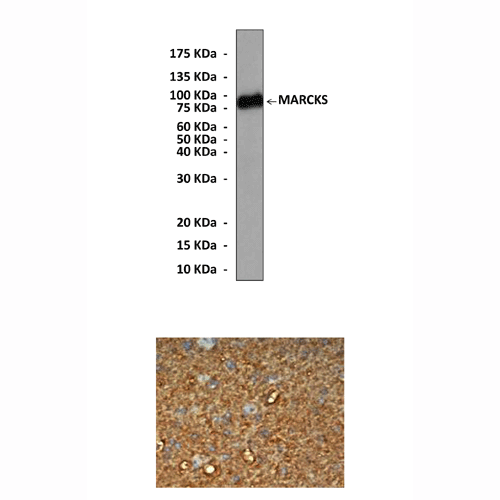Anti-MARCKS: Rabbit MARCKS Antibody |
 |
BACKGROUND MARCKS (myristoylated, alanine-rich C kinase substrate) is prototype of one class of PKC substrates. It has been employed for decades as an indicator or marker for PKC activation in intact cells. The proteins of the MARCKS family have been implicated in the regulation of brain development and postnatal survival, cellular migration and adhesion, as well as endo-, exo- and phago-cytosis, and neurosecretion.1 MARCKS proteins possess three highly conserved regions. The N-terminus represents a consensus sequence for myristoylation, a co-translational lipid modifcation attaching myristic acid; the C14 saturated fatty acid, via an amide bond to the amino group of the N-terminal glycine residue. The MH2domain, of unknown function, resembles the cytoplasmic tail of the cation-independent mannose-6-phosphate receptor and is also the site of the only intron-splicing event. Finally, the phosphorylation site domain contains all serine residues known to be PKC phosphorylation Sites (Ser152, 156 and 163). This domain has been shown to be central to the function of MARCKS proteins, and is therefore called the effector domain, which is highly basic. The effector domain of MARCKS proteins is phosphorylated by PKC, binds to calmodulin and contributes to membrane binding. Phosphorylation of MARCKS by PKC decreases its affinity for CaM and actin, as well as the association with membranes. On the other hand, CaM bound to MARCKS sterically hinders access of PKC to MARCKS and thus its phosphorylation and is thus able to pull MARCKS off membranes. If CaM and PKC are both active, they can compete for their commonsubstrate MARCKS. MARCKS can therefore mediate crosstalk between the PKC and CaM signal transduction pathways.2
MARCKS cycles on and off membranes by a mechanism termed the myristoyl–electrostatic switch. While at the membrane, MARCKS binds to and sequesters acidic phospholipids including phosphatidyl-inositol-4,5-bisphosphate (PIP2). MARCKS also binds and cross-links filamentous actin, an activity which is regulated by PKC-dependent phosphorylation and calcium–calmodulin. MARCKS plays important role in phagocytosis, secretion, and/or membrane recycling. It was shown that MARCKS and PKC regulate actin-dependent membrane ruffling and cell adhesion, perhaps via a PIP2-dependent mechanism.3
REFERENCES
1. Arbuzova, A. et al: Biochem. J. 362:1-12, 2002
2. Arbuzova, A. et al: Biochem. Biophys. Acata 1376:369-79, 1998.
3. Myat, M.M. et al: Curr. Biol.7:611-4, 1997
2. Arbuzova, A. et al: Biochem. Biophys. Acata 1376:369-79, 1998.
3. Myat, M.M. et al: Curr. Biol.7:611-4, 1997
Products are for research use only. They are not intended for human, animal, or diagnostic applications.
Параметры
|
Cat.No.:
|
CG1298
|
|
Antigen:
|
Short peptide from human MARCKS sequence.
|
|
Isotype:
|
Rabbit IgG
|
|
Species & predicted
species cross-
reactivity ( ):
|
Human
|
|
Applications &
Suggested starting
dilutions:*
|
WB 1:10000
IP n/d
IHC 1:100 - 1:250
ICC 1:100 - 1:250
FACS 1:50
|
|
Predicted Molecular
Weight of protein:
|
87 kDa
|
|
Specificity/Sensitivity:
|
Detects endogenous MARCKS proteins without cross-reactivity with other family members.
|
|
Storage:
|
Store at -20°C, 4°C for frequent use. Avoid repeated freeze-thaw cycles.
|
*Optimal working dilutions must be determined by end user.
Информация представлена исключительно в ознакомительных целях и ни при каких условиях не является публичной офертой








